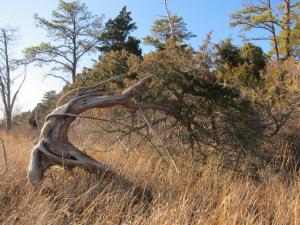Communing with Native Americans on last day of the season
We hunted and gathered last weekend and felt kinship with Native Americans of long ago.
Albert the marsh guide, a hunting partner of many years, and I shoved off from the launching ramp in Lewes’s Canalfront Park on the last day of the 2011-12 waterfowl hunting season. It was mid-morning and we passed a couple of other hunters in their camouflaged johnboats pushing up the canal with small engines. They were on their way back in from the marshes.
Duck hunters traditionally have their decoys set and are settled in their blinds 45 minutes or so before sunrise. Shooting time is a half hour before sunup and the gunners like to be in place before the early morning flight.
But we were in an Old Town canoe, almost as old as we are. No engine. We weren’t about to paddle against the tide for a couple of miles just to shoot the single black duck the law allows. We may have gotten a shot at some of the buffleheads that hang out on the canal. Some people call them butterballs because of their plump breast meat, but their flavor is too gamey for most. They weren’t enough of an attraction to change our hunting plans.
Not a cloud in the sky, bright sunshine cut through the cool air like a heat lamp and winter colors of blue, brown and green seeped into our eyes like oil paintings.
The rising tide was two thirds into its flood, and the current took hold of us when we moved away from the launching ramp into the canal’s full stream. It gave us a two- or three-knot advantage as we headed south toward the wilds of the cape marshes, and we made good time with a civilized pace of paddling.
We looked at osprey nests thick with sticks piled four feet high on pilings along the canal, and human nests in Wolfe Runne and Wolfe Pointe overlooking the healthy spartina marshes of Wolfe Glade. To the east, we counted off several of the progated spit tips that carry long tongues of high ground and tall pines from Cape Henlopen State Park into the marshes. I have to thank Wendy Carey for introducing “progated spit tips” into my bag of words and phrases. Wendy is part of the marine education outreach team in University of Delaware’s Sea Grant program.
Progated spit tips?
Twenty years ago, Wendy explained the spit tips concept to me when I was talking about the cool deer trails that dive off the main body of the Cape park pine forest toward the canal on narrow strips of pine-studded land. She said those formations are the remnants of former spit tips that developed over thousands of years on the point of Cape Henlopen. Dominant winds out of the northeast and northward-running currents along the coast curled the spit tips around toward the southwest. They eventually stabilized with dunes, marsh grass and trees and then new spit tips started forming beyond them, separated by shallow bays and marshes. How cool is that?
Native Americans liked them too, but more on that in a minute.
We paddled southward toward Gordons Pond, the high rise at North Shores and Rehoboth, and stopped for a moment at the wooden, mid-canal structures where I’m told a water line crosses the canal on its way to the World War II Fort Miles facility. Praise God for the good sense that led some enlightened person to install four or five solar-powered lamps on that dangerous structure. It needs more, but the lamps are at least a start. The heavy wooden timbers near the center of the canal are just waiting for an inattentive boater out on a dark-night lark to create a tragic encounter.
South of those structures, a wide gut forks from the canal to the east. We carried the current into that gut and eventually scared up 50 black ducks from a pond at the head of another branching gut. They helicoptered off the water before leveling off and clearing the pines on their way to Gordons Pond.
A shining white mound to the left caught our eyes as we paddled toward the black duck pond. On one of the spit tips, the uprooted base of a large, fallen pine displayed the former feasting grounds of Native American tribes. The tree had grown over top of one of the park’s many shell middens - a refuse heap from a different age. The spit tips offered fine access to shellfish beds in shallow bays inside the tips, just like the shellfish-loaded bay inside the point of Cape Henlopen now. The shellfish gatherers left behind heaps of clam and oyster shells. The pine tree, its roots at one time growing around and through the heap, revealed one of those middens for us to explore when it fell over and brought the shells to the surface.
We finished exploring, ate salami and cheese sandwiches and apples on a pine-needled bank, and bagged one of the black ducks. By then it was time to head back to Lewes.
The flood tide had turned. Ebbing with considerable teeth, it aligned with a southwest breeze at our backs, emptying the marshes and giving us once again a strong current to carry us, this time, back to town. Jiggity jog.
Not a bad way to spend the last day of the season.
























































